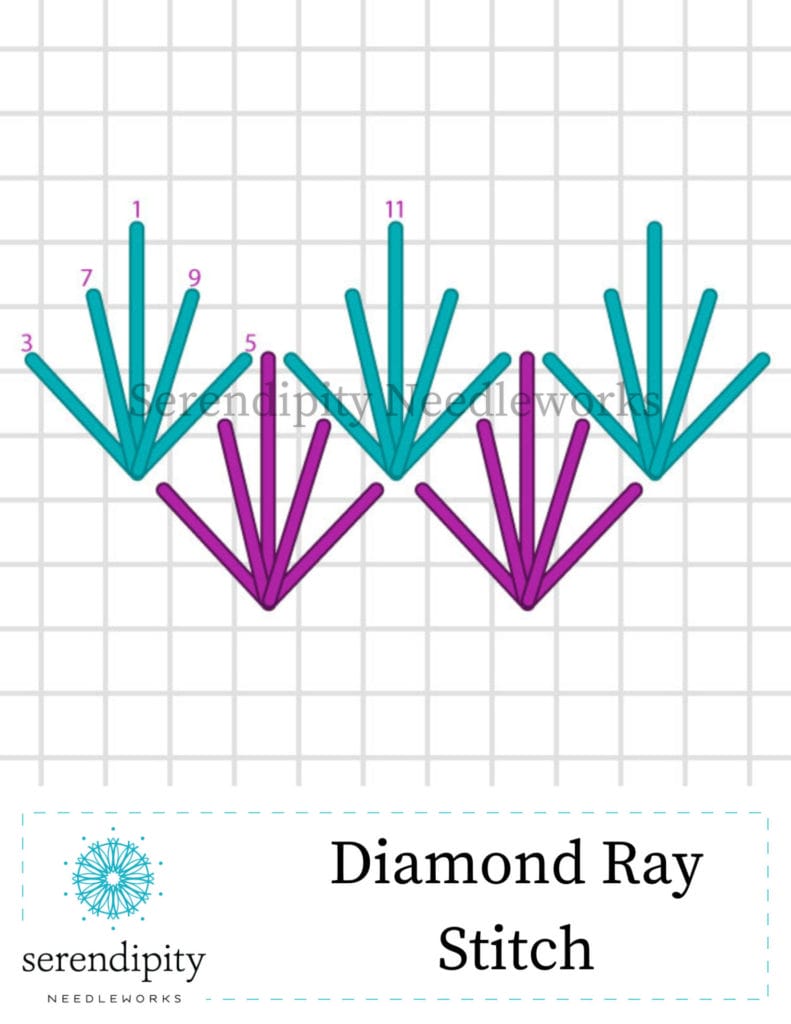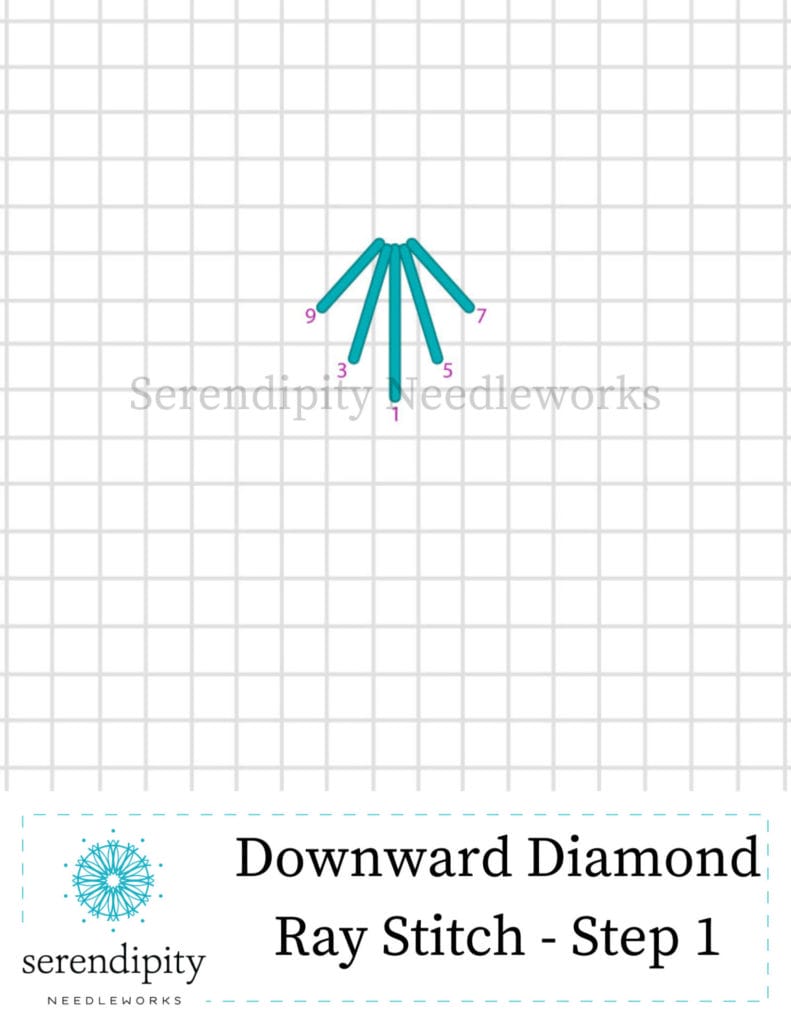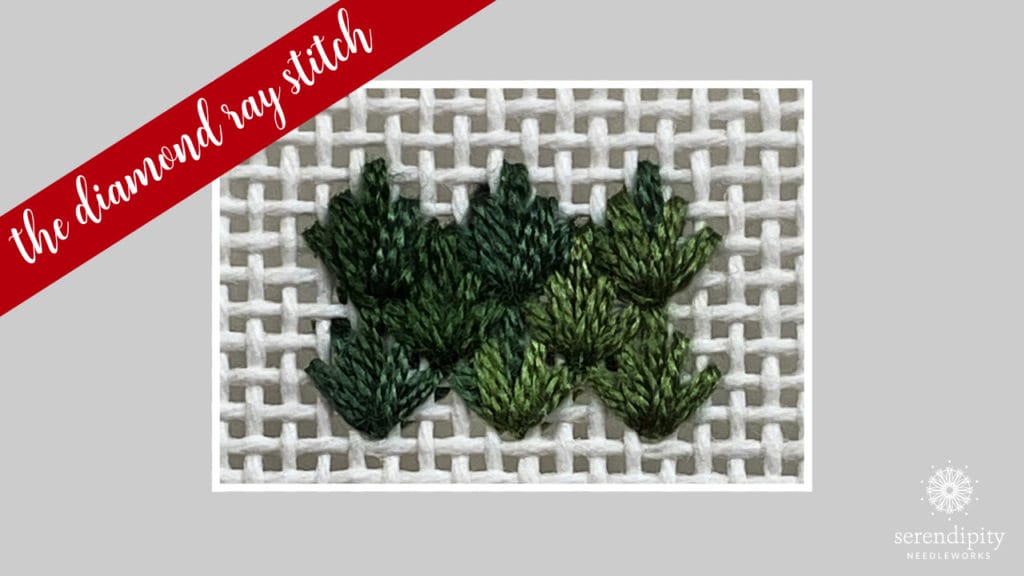Winter doesn’t officially begin until December 21st, but since we’re almost there, let’s take a peek at a stitch that you can use on your winter themed canvases… the diamond ray stitch!
The diamond ray stitch is an eyelet stitch…
which means that several stitches share a single hole.
Here’s the diagram for you.

Notice how only the odd numbers are shown on the diagram? That’s because there’s not enough space to include all of the even numbers without it looking jumbled.
There are a couple of tips to keep in mind when executing eyelet stitches.
- When working with a single strand thread, use a lighter weight thread than you would typically use because multiple stitches are sharing a single hole. (Too much thread jammed into the same hole will result in a blobby mess.)
- When working with a divisible thread (e.g., Splendor or DMC cotton floss), use fewer strands than you would typically use. It’s the same principle – you want to be able to see the individual stitches that make up each diamond ray stitch unit instead of a big blob of thread.
One of the things I L-O-V-E about the diamond ray stitch is that it’s a smallish size stitch.
That means it will fit in a variety of spaces. And you can rotate the stitch unit to create different directionalities. For example, you can flip the stitch 180 degrees so that it’s upside down, like this…

Or you can turn it 90 degrees so that it’s laying on its side. You can even sprinkle single stitch units across an area for a more random look.
The diamond ray stitch is an excellent choice for foliage and feathers.
Let’s chat about employing it for foliage, first.
There are some charming painted canvases that feature wintry scenes. This Melissa Shirley design, called Christmas Houses, would actually be quite perfect for the diamond ray stitch.

Imagine using one of the gorgeous subtly over-dyed threads from Weeks Dye Works to stitch the diamond ray pattern on those evergreen trees behind the houses. The results would be splendiferous! Here are a few of my favorite hues that are perfect for stitching evergreen trees: Blue Spruce (1276), Collards (1277), Holly (1279), Verdigris (1280), and Juniper (2158).
You may also use the diamond ray stitch to create realistic looking garlands and wreaths. Adjusting the direction of the stitch units to follow the painted design can be very effective – and so can mixing thread textures.
One especially compelling combination involves blending Watercolors pima cotton thread with Waterlilies silk floss. Both of those threads, from The Caron Collection, are dyed using the same dye recipes, but because the base threads are different fiber types, the colors look somewhat different in the skein (and when stitched up). In other words, you might think that a skein of Watercolours Emerald and Waterlilies Emerald are not even related because silk absorbs dye (and reflects light) differently than cotton.

All of that to say – you can mix the two textures of thread to create more depth and visual interest than if you were using just one texture of thread. To create lifelike evergreen foliage, work a base layer of diamond ray stitches in Watercolours, then come back and scatter individual diamond ray stitch units on top in Waterlilies.
You may also use the diamond ray stitch for fantabulous feathers.
I usually opt for the “sideways” variation of the stitch when working bird wings, but you may choose to adjust the angle of the stitch units to follow the painted design on your canvas, just like when stitching evergreen trees and garlands.
This is another time when mixing thread textures can be quite impressive, too. Think about the texture of bird feathers – some are a little fuzzy and some are very sleek. Here’s a winning combination for brilliant red cardinals: Fuzzy Stuff (FZ18), Waterlilies and/or Watercolours “Cardinal”, and Waterlilies and/or Watercolours “Flame”. Ooh la la… soooo gorgeous!!

Have you ever used the diamond ray stitch for foliage or feathers? Or maybe you’ve used it for another kind of design component on a canvas? I’d love to hear from you, so share your comments down below. 🙂
Alrighty, my friend – that’s all for now. I hope you have a fantabulous week and I’ll see you here again next time. Until then…
Happy Stitching
XOXO!!

PS: Do you follow me on social media? If you don’t, you’re missing out on some terrific tips and needlepoint goodness. 😉





I used the Diamond Ray stitch on parrot feather on Alice Peterson small purse. Very cute. 🦜
Ooooh – that sounds lovely, Shirley! Thank you for sharing.
XOXO!
Ellen
Thanks so much for all you do to educate us! I have a Melissa Shirley stocking and this stitch will be perfect for the trees! Would you mind sharing the thread used in the stitched sample (first photo)? Thanks again!
Hi Robin
I’m so glad you found the blog post helpful. The thread I used in the picture is Watercolours by The Caron Collection. Good luck with your stocking project. I have one to stitch for my new granddaughter in 2023! 🙂
Happy stitching!!
XOXO!
Ellen
I’ve enjoyed doing embroidery and needlepoint this past week and will keep on with all my projects for the next 2 weeks and beyond. Thanks for sharing new stitches .